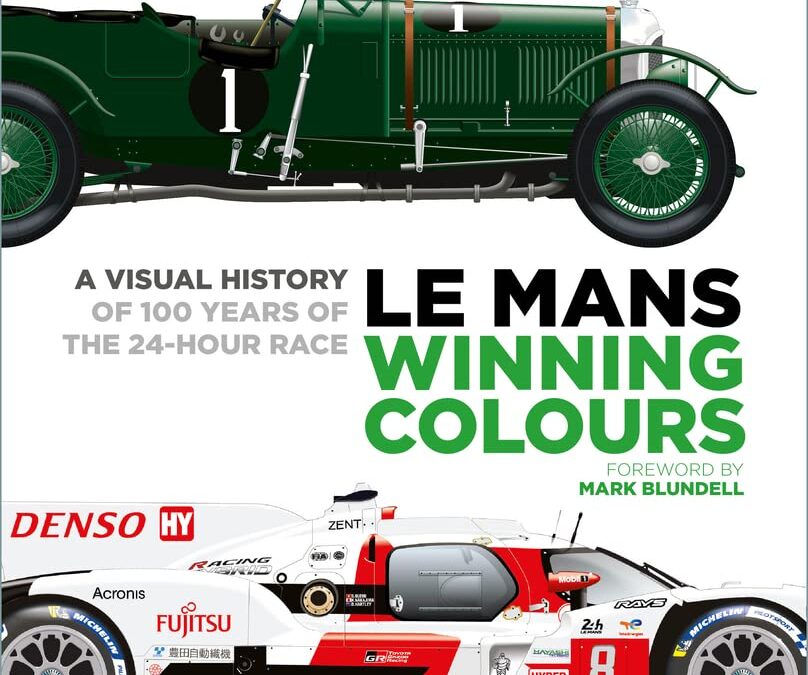

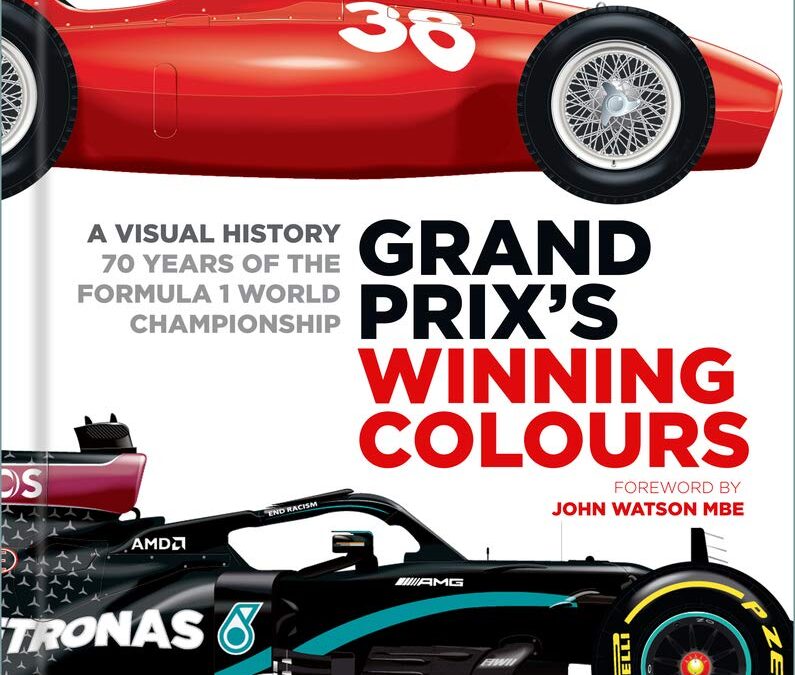
Grand Prix’s Winning Colours: A Visual History – 70 Years of the Formula 1 World Championship
Mick Hill’s colorful book is packed with his signature artwork, and skillfully showcases the cars, drivers, and designers that contributed to the history of Formula 1. Beginning with the flags for hosting countries, it goes on to show every winning car, with details of its designers, drivers, and races won. The book also considers drivers’ helmets, from historic leather caps to modern carbon fiber, as well as the world championship stickers from teams and sponsors, a memento for fans to the race meetings they attended. A complete reference of the first 70 years of the F1 championship, this book will appeal to motor racing fans young and old.
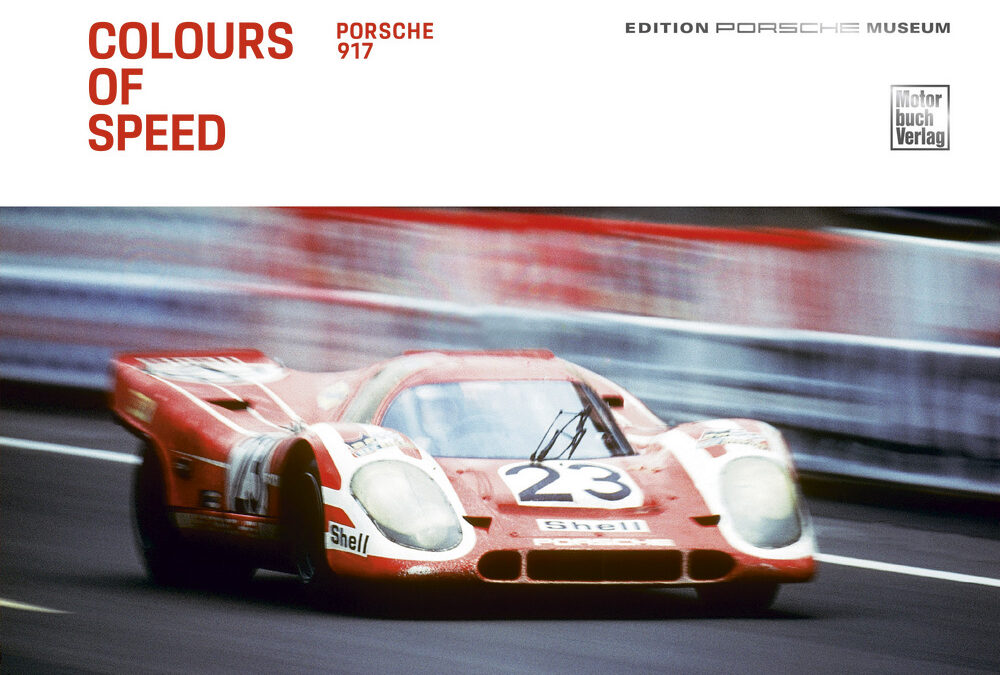
Colours of Speed – Porsche 917
The Porsche 917 made its debut at the Geneva Motor Show in 1969. When the FIA raised the engine capacity limit for the sports car championship to five liters in 1968, Porsche saw their chance: within a year, constructor Hans Mezger created the car. The 917 already achieved the goal of overall victory in the 24 Hours of Le Mans in 1970 and 1971, and later drove up to 1100 turbo horsepower in the CanAm series. With this book from the Edition Porsche Museum the Company Archive presents the background to the origins, technology, drivers, races and successes of the Porsche 917, with a special focus on the rainy race 50 years ago.
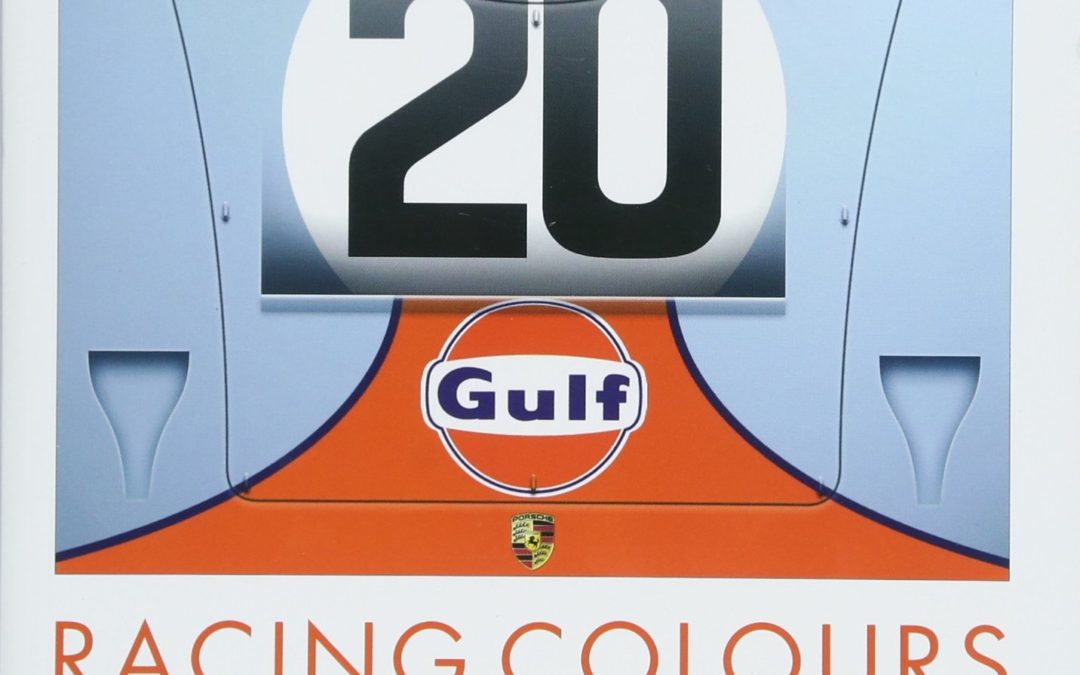
Racing Colours: Motor Racing Compositions 1908-2009
In many respects it is a book unlike many others. It is an individual, as all good books should be. It is quirky, eclectic, eccentric even, but in a world intent on reproducing that which has already been regurgitated I personally felt the need for something a bit more idiosyncratic, I can only hope that you agree!” – Simon Owen
A well known artist specialising in racing car subjects, the late Simon Owen’s detailed, expertly executed work conveys the life, the vibrancy, the essence and passion of motorsports and racing cars, like no other. Simon’s work is a visual feast for lovers of automotive art and motorsport. Over the last few years, Simon had worked on developing a series of stunningly detailed computer-generated digital images, focusing on individual racing cars and their liveries. Seventy-seven of these images have been compiled to create Racing Colours, and each is presented with a relevant quote from a legend of the motor racing world. Along with these beautiful and unique artworks, this book represents a chance to gain a rare peek into the artist’s working methods, revealing some of his developmental work and showing how the digital images were constructed.
Airline Tail Colours
Gerry Manning
Jagdwaffe:Luftwaffe Colours 4
Jean-Louis Roba

Superbears: The Story of Hesketh Racing
Hesketh Racing was a Grand Prix phenomenon. In a time of increasing commercialisation and cars that had forsaken national racing colours in favour of sponsors’ logos, the team was privately funded by Lord Hesketh – a patriotic 22-year-old who was determined to take his promising young driver, James Hunt, to World Championship glory. Their car stood out on the track thanks to its pure white livery – and the team stood out in the paddock thanks to its lavish hospitality, its helicopter and yachts, and its infectious sense of fun.
But behind the playboy image was a highly professional team, expertly organised by Bubbles Horsley and including talents such as designer Harvey Postlethwaite, engineer Nigel Stroud and chief mechanic Dave ‘Beaky’ Sims. Having arrived in Formula 1 in 1973 with a rented March, Hesketh Racing then set about building its own car. It won the 1974 International Trophy at Silverstone and the 1975 Dutch Grand Prix at Zandvoort – putting James Hunt on the road to superstardom.
This new book from Porter Press International is the first to tell the amazing full story of Hesketh Racing. ‘The biggest little team in the world’ captured the imagination of enthusiasts all around the world thanks to its unique approach and its famous teddy bear logo, and it continues to be one of the most evocative and charismatic names in Formula 1 history.

Range Rover Third Generation: The Complete Story
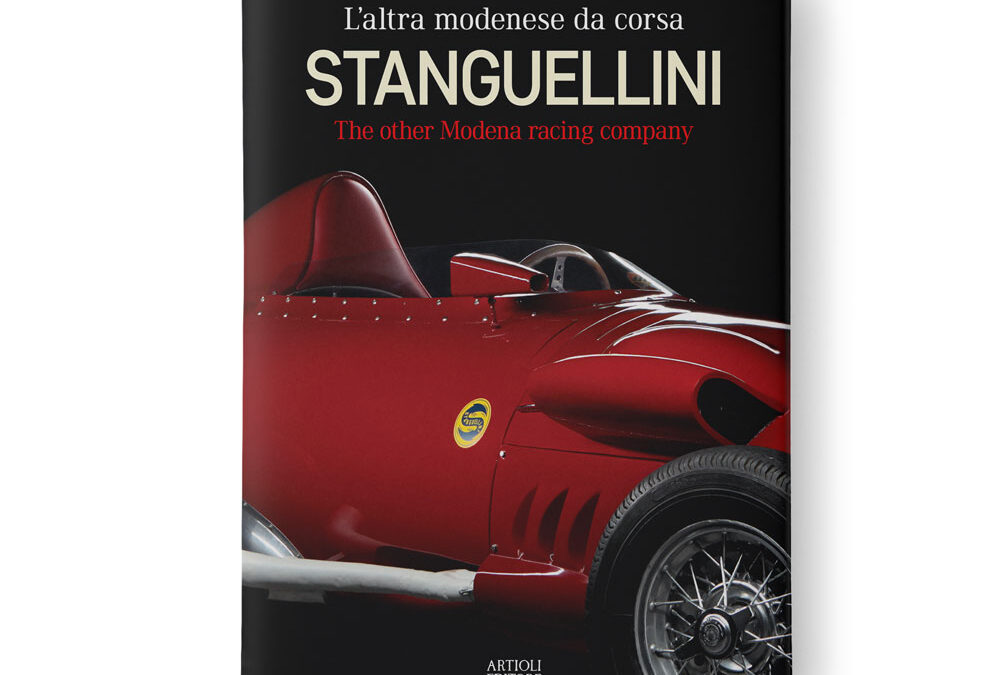
STANGUELLINI The other Modena racing company
The first of the ten chapters included in the book is a bit of a provocation. In fact, it recalls how a ‘small’ Stanguellini Sport 1100 car, thanks to excellent road holding, beat the new and still ‘green’ Ferrari with a 12-cylinder engine of 1500 cc, in some races of the 1947 season, the debut one for the newly-founded Prancing Horse manufacturer. The ‘snub’ received from another Modena-based company, which was just as committed to the construction of sports cars, albeit with a smaller engine displacement, certainly annoyed Enzo Ferrari but in any case, he had very little to complain about. He had too much respect and friendship for the ‘Magician’ Vittorio Stanguellini, ever since the latter showed up in Modena racing circles in the company of his father Francesco, a pioneer of local motorsport. Stanguellini of Modena was a large family: in the second half of the 19th century, Celso, father of Francesco Sr., had founded a company for the construction of orchestral kettledrums with patented mechanical tuning. From there, it was a short step to the ‘mechanics’ of automobiles: Francesco Sr. became Fiat’s first representative in Modena, while his son Vittorio later extended the agreement with the Turin-based company, but his passion and technical ability also lead to the tuning and construction of racing cars as early as the early 1930s. Vittorio certainly knew his way around and he put together a small empire, based above all on the Sport 750 and 1100: the workshop in Viale Moreali, and later the larger one in Via Schedoni, become a worldwide benchmark, which from 1958/59 was confirmed with the construction of the Formula Junior cars (what would later become Formula 3), intended for up-and-coming drivers. The Stanguellini Formula Junior with a 90 hp Fiat 1100 engine and a top speed of 200 km/h was the most popular and successful car in the crowded category. However, the Formula Junior regulations required that the engine was derived from a production car, albeit with a wide range of tuning possibilities. As he was linked to Fiat, in the 1960s Vittorio Stanguellini, now flanked by his son Francesco Jr., built some Formula Junior (including the modern ‘Delfino’) and then Formula 3 single-seaters, with engines derived from the ‘1300’ and ‘124’ of the Turin-based company. Thanks to the copious archive material of the brand (photographs and documents), the book reconstructs in detail the history of the manufacturer from the blue ‘S’ on a yellow background (the colours of Modena), summarized by the extensive Museum, set up at the time by Francesco and now impeccably curated by his daughter Francesca: fifth generation of the ‘racing’ Stanguellini family. A chapter of the book is dedicated to the Museum and it is basically a ‘guided tour’ of the cars and the curiosities it hosts. The same cars, perfectly restored, were photographed outside in a spectacular way and can be admired in the ‘portfolio’ combined with the same book.
Hardcover
English and Italian Text
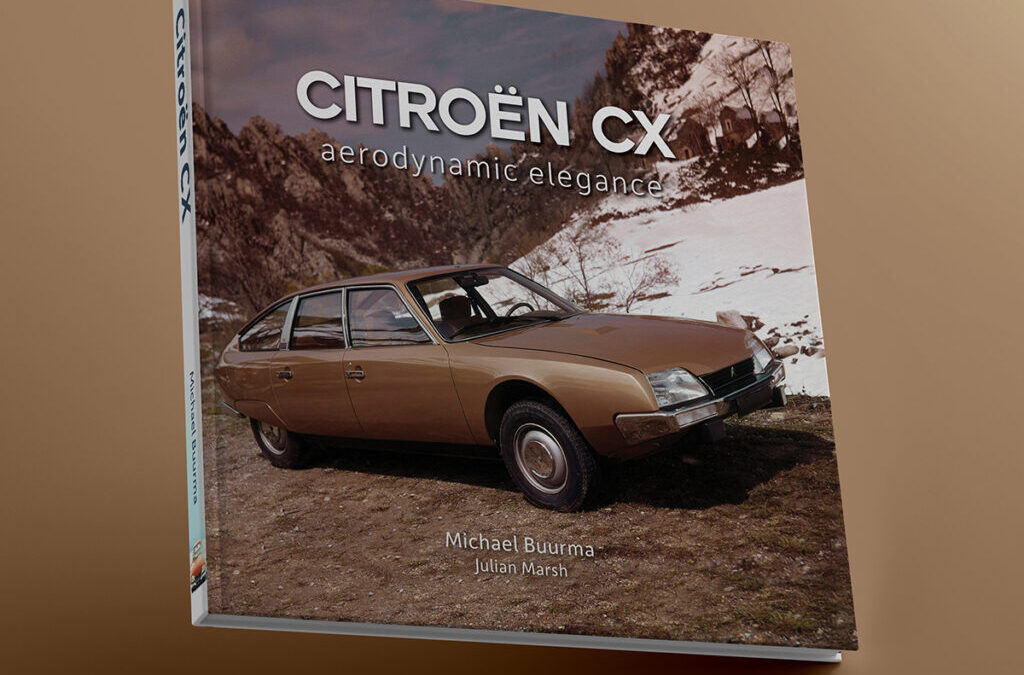
Citroën CX Aerodynamic Elegance
CX experts Michael Buurma and Thijs van der Zanden of Citrovisie joined forces to create a unique CX-book. In an almost encyclopaedic manner, and with great attention to detail, the creation and evolution of the Citroën CX is discussed by model year, by type and down to the smallest detail. This also includes the models that never got beyond the drawing board: a five-door CX, numerous never realised interior designs, a CX GTi with a diesel engine and an extended CX Pallas, to name but a few… Overviews with technical data, chassis numbers, body colours plus sales figures complete the picture. The book is amply illustrated with hundreds of images, most of which have never been published before. This makes ” La véritable histoire de la Citroën CX” an indispensable reference for the real Citroën lover.
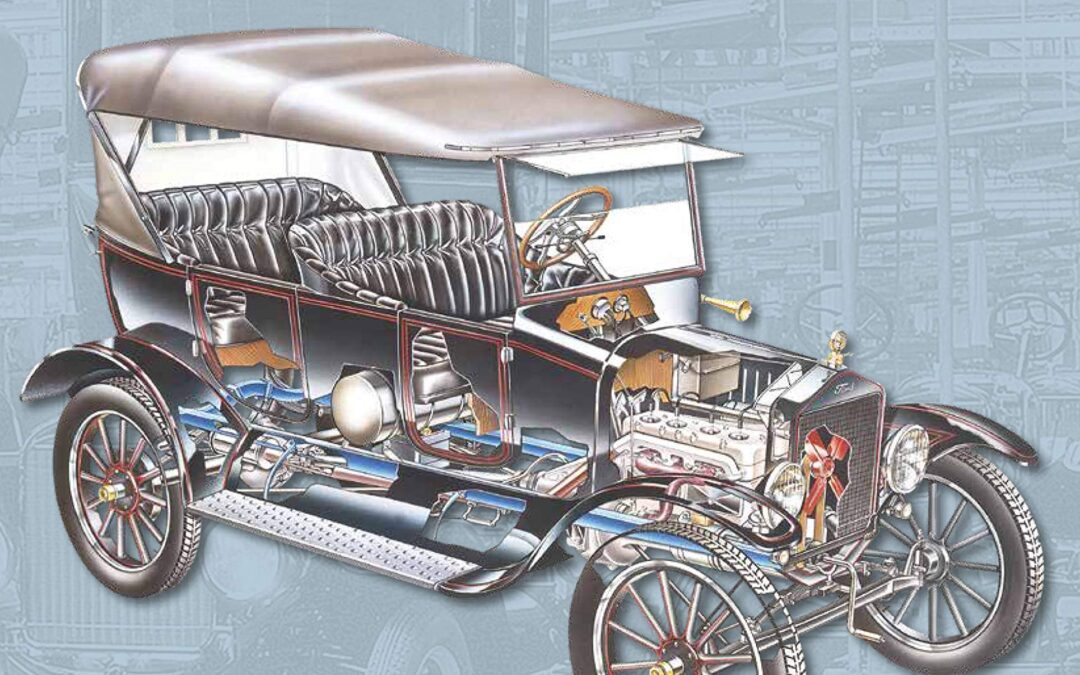
Ford Model T: An Enthusiast’s Guide 1908 to 1927
“I will build a car for the great multitude,” stated Henry Ford, and so he did.
The Ford Model T, or the ‘Tin Lizzie’ and the ‘Flivver’ as it was also known, transformed American society, bringing mobility through car ownership to millions of middle-class Americans at a time when the horse and the railroad were the only real viable means of transport.
Using moving assembly lines and the best possible materials, between October 1908 and May 1927, Ford built around 16.5 million examples of this extraordinary car. By 1918, half of all cars built in America were Model Ts and by 1925 around 8,000 a day were being produced, making Henry Ford one of the world’s best-known manufacturers of automobiles.
The selection of body styles varied from two- and four-seat open and closed models – tourers, town cars, runabouts, landaulettes and cabriolets – to vans and pick-up trucks, and customers could also have colours other than black!
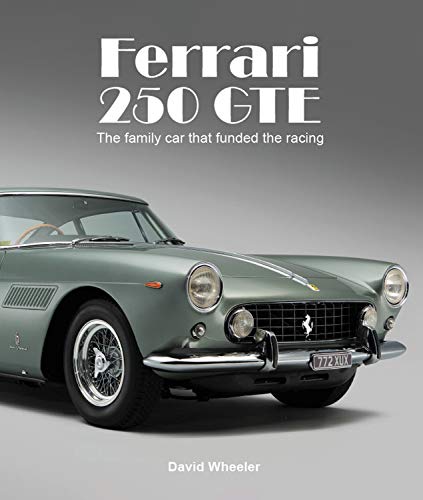
Ferrari 250 GTE: The family car that funded the racing
SOLD OUT
First seen as the course car at the 1960 Le Mans 24 hour race, the elegant Ferrari 250 Gran Turismo 2+2 Pininfarina, or GTE as it has become known, was Ferrari’s first four-seat production car and an outstanding commercial success, underwriting the company’s racing activity.
Built upon the same running gear as the iconic Ferrari 250 two-seaters, the GTE continued in production until 1963, by which time 954 examples had been built. Initially popular as a “gentleman’s express,” the car was typically finished in conservative colours which emphasised its stunning lines.But after a few years and several owners they were sadly often neglected and came to be regarded simply as donors upon which to build replicas of other Ferraris.
Thanks to the efforts of a number of enthusiastic owners who have dedicated themselves to maintaining, restoring and preserving these wonderful cars, about half of them still exist today as GTEs, valued for their beauty and history. In researching this definitive history of the model, the author consulted with respected Ferrari historians, enjoying access to their archives. He traveled extensively to view and document more than 125 examples of these cars around the world. The book is published in a limited edition of 750 copies to c
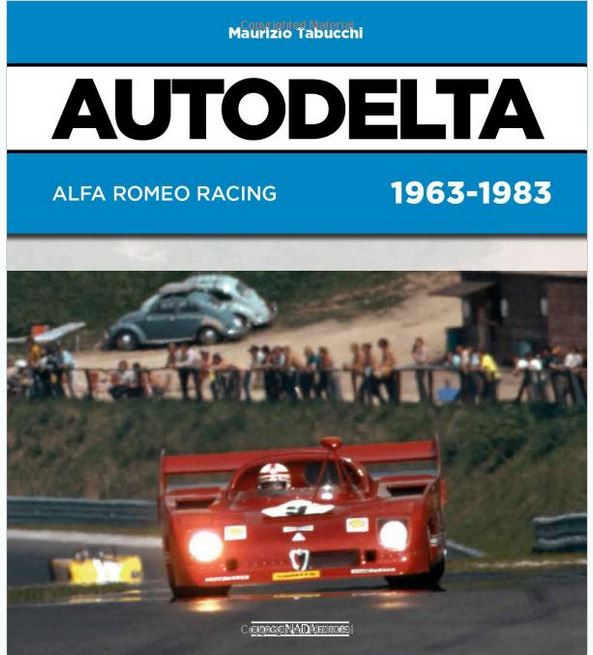
Autodelta: Alfa Romeo Racing 1963-1983
The Autodelta story, Alfa Romeo’s more or less official racing department between 1963 and 1983. A tale of unforgettable victories, of two titles conquered in the World Championship for Marques, but also one of scalding defeats. Great names in the history of motorsport raced in the colours of the team born in the province of Udine and nurtured at Settimo Milanese including Ignazio Giunti, Nino Vaccarella, Andrea de Adamich and Toine Hezemans. All drivers who competed – under the aegis of the incomparable Carlo Chiti – at the wheel of unforgettable cars such as the Giulia TZ, the GTA, the 33 in its various guises, the Alfetta GT rally cars and naturally the less successful Formula 1 machines. All this is revived in a book constructed around painstaking research and illustrated with hundreds of photographs, many of which previously unpublished
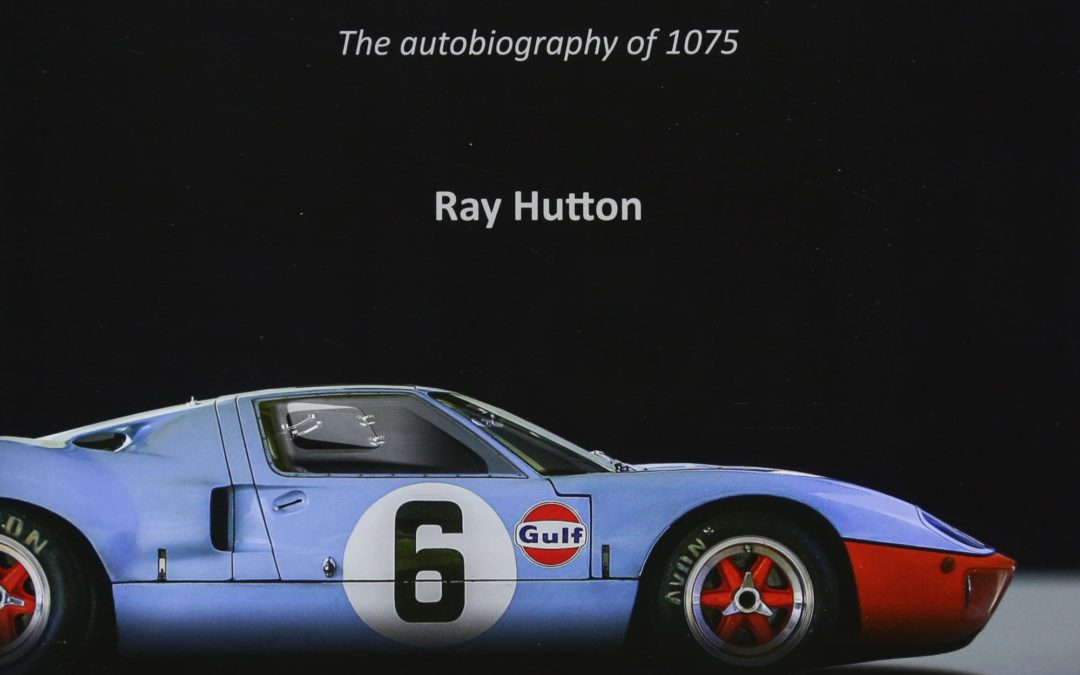
Ford GT40: The autobiography of 1075 (Great Cars)
This sumptuous book tells the story of one of the world’s most important racing cars. Always raced in Gulf’s iconic blue-and- orange colours, this Ford GT40, known by its chassis number ‘1075’, won the Le Mans 24 Hours not just once but twice, in 1968 and 1969, and the second victory came after the closest fight ever seen at the finish of this great endurance race. Four other championship wins – at Brands Hatch, Spa, Watkins Glen and Sebring – add to this GT40’s distinction as the very best of its breed, driven by ‘greats’ such as Jacky Ickx, Pedro Rodríguez and Brian Redman. The car’s entire competition life is covered in fascinating detail, together with biographies of its drivers and insights into John Wyer’s crack team that ran it, all supported by a fine collection of period photographs.
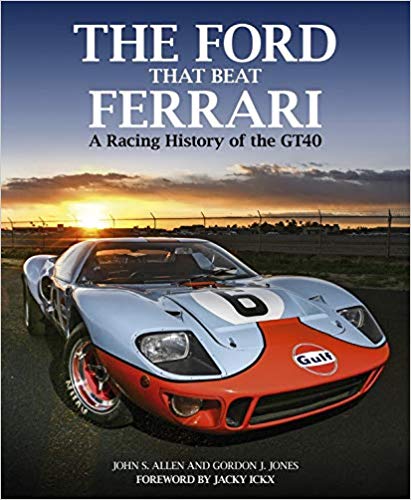
The Ford that Beat Ferrari: A Racing History of the GT40 3rd Edition
After Ford unsuccessfully attempted to buy Ferrari, in 1963, the American car giant instead embarked on its own racing programme in a bid to beat the famous Italian marque at the world’s most prestigious race, the Le Mans 24 Hours, as told in the forthcoming Hollywood movie Ford v. Ferrari. This updated edition of The Ford that Beat Ferrari tells the story of how that mission was eventually accomplished.
- Development of the GT40: how the prototype Ford GT emerged in 1964 from the previous year’s Lola GT programme.
- The works teams and the GT40: the car’s racing exploits in its earlier years, first with Ford Advanced Vehicles (1964), then Shelby American (1965) and Alan Mann Racing (1966).
- The big ones: this section of the book covers the GT40’s evolution into the 7-litre monsters that brought enormous success, including the first two Le Mans victories with the Mark II (1966) and Mark IV (1967), before becoming outlawed by new restrictions on engine size.
- The Gulf years: against all expectations, the venerable GT40, now back to 5-litre power, raced on with John Wyer’s crack JW Automotive Engineering outfit in the iconic blue and orange colours of Gulf, successes including two further Le Mans wins (1968 and 1969).
- The production line racer: the stories of the 68 privateers, big and small, who raced GT40s.
- Chassis and drivers: a data section giving resumés of type designations, chassis histories and all drivers who raced GT40s.
- The magic lives on: the book’s concluding sections show surviving cars at differing stages in their later life and bring the story up to date with developments since the 2005 edition

Mitchell Masterpieces Vol 1
An illustrated history of paint jobs on B-25s in U.S. service
This book is an illustrated history of paint jobs on the North American B-25 Mitchell in service of the United States armed forces. It is a never before published overview of the various paintings of the B-25s, which have flown in the different U.S. units all over the world. The airplanes were mostly standard painted in camouflage colours in the factories, whether or not suited for the operational area where they were employed. Thereafter, in the field, often operational and/or personal markings were applied, and primarily nose art was very popular. Stars from the Hollywood film industry, many cartoon characters and personal markings dominated the noses of the bombers.
The Second World War was to become the golden age of airplane nose art and showed many masterpieces. But also later in the war and after the war, the shiny aluminium B-25s with their markings were masterpieces to see. A lot has been published about airplane nose art, but not entirely focused on the B-25. This book will fill this gap and it is not just about nose art, but it also focuses on other paintings and their background thoughts. In this book, the bombardment groups and squadrons are described briefly and it includes just about 900 illustrations.
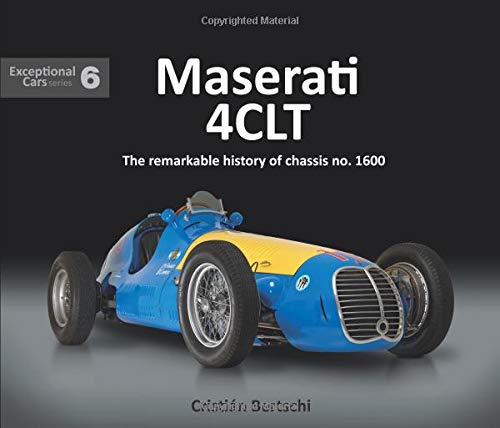
Maserati 4CLT: The remarkable history of chassis no. 1600 (Exceptional Cars)
The latest in the Exceptional Cars series tells the story of one of the two cars bought by The Automovil Club Argentino (ACA). Painted in the bright blue and yellow Argentine racing colours, 1600 was to play an important role in the Argentine team’s international expeditions to Europe. Fangio won two races in the car, the most important being at Pau in 1950, where he repeated his win in the ACA sister car a year earlier.
As well as a detailed chronicle of the car’s highs and lows, the text includes profiles of the drivers who raced in 1600 and a personal account of driving and running the car by a former owner who describes the daunting task of re-creating a Maserati 4CLT engine from scratch.
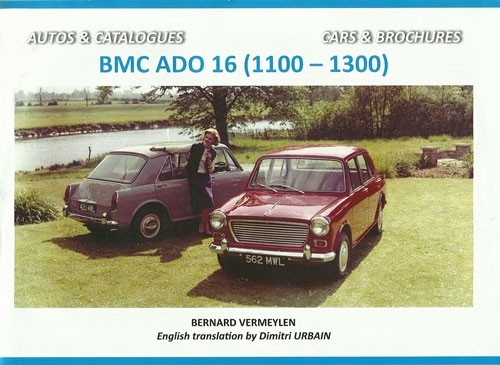
BMC ADO 16 (1100 – 1300)
The BMC ADO 16 (Austin Drawing Office 16) Morris 1100 car was revealed to the international motoring press on 15th August 1962, a larger and worthy companion to the BMC Mini which had been launched in 1959 to worldwide acclaim. Both designs were the work of Alec Issigonis and featured transverse engines with the gearbox in the sump, driving the front wheels, groundbreaking technology at the time which has been universally adopted since, though not the gearbox in the sump. A further revolution was the suspension; the Mini had progressive springing by rubber cones, the work of rubber technician Dr. Alex Moulton which, together with rack-and-pinion steering, was responsible for the Mini’s incredible road-holding. The larger Morris/Austin 1100 series cars were fitted with a developed version named “Hydrolastic”. Suspension was still by Dr. Moulton’s rubber cones, but associated with a chamber filled with water and antifreeze and incorporating damper valves, which was connected to similar rear units via pipes and was a form of self-levelling. A unique solution to the problems associated with large differences between laden and unladen weights in small family cars.![]()
Bernard Vermeylen’s fascinating book, with English and French text, studies the design, technologies and development of Issigonis’s and BMC’s hugely-successful ADO 16 design, which lasted for over 10 years and evolved from the Austin/Morris 1100 to the 1300 cars, which in turn were built in a bewildering variety of badge-engineered makes; Vanden Plas Princess, MG, Riley Kestrel and Wolseley, as well as being licence-built in Italy (Innocenti), Spain (Authi), Australia (Nomad), New Zealand and South Africa (Apache). BMC themselves produced GT versions, Traveller and Countryman estate cars and a variety of different spec. models for various markets.
Most of the illustrations in this book take the form of images from factory brochures and press photos, detailing the many changes BMC made to the ADO 16 in the decade it was in production. Specifications of different models, paint colours and sales prices are all listed in Bernard Vermeylen’s book, it is as comprehensive a survey as is possible and particularly interesting for the details published on the many export and licence-built variants of BMC’s 1100/1300 cars.

Lotus 79 1977 onwards (all models)
An insight into the design, engineering and operation of the pioneering Lotus ground-effect Formula 1 car
The Lotus 79, with its classic JPS black and gold sponsorship colours, was the first F1 car to fully exploit the potential of ground-effect aerodynamics. Designed by Colin Chapman and his engineering team, the Lotus 79 dominated the 1978 World Championship, taking US driver Mario Andretti with his only F1 World Championship.
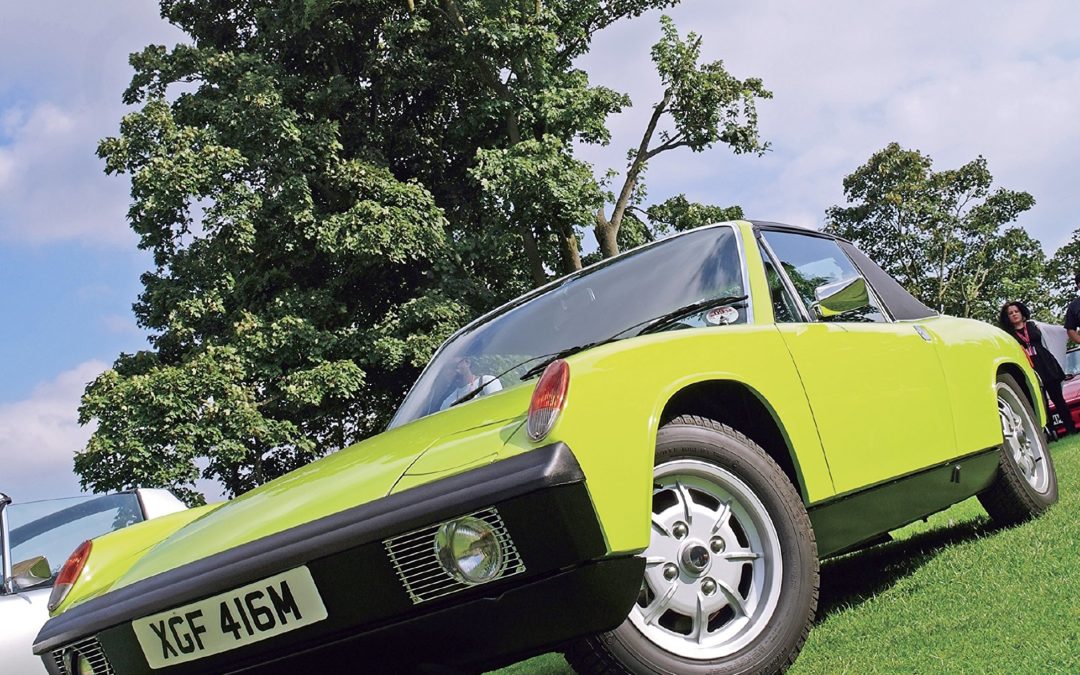
Porsche 914 – An Enthusiast’s Guide
The 914 was born into consistently confusing and troubled times at Porsche and Volkswagen. The idea of a non-911 Porsche in the late 1960s horrified many. A Porsche with an engine that wasn’t in the back was simply unthinkable. Richard Gooding examines the story of a car of mixed parentage, which against the odds became a success in its relatively short, six-and-a half year lifespan. Around 119,000 cars were sold from 1969 to 1975, outselling contemporary rivals such as the Opel GT, and meaning it was the first mid-engined car to achieve six-digit sales.
As a present-day classic, although challenging to some, low-slung looks and bright colours make the 1970s 914 period-perfect. Combined with near-ideal weight distribution and a low centre of gravity, its mid-engine layout means the 914 can achieve cornering G-forces comparable to the contemporary 911. The 914 was seen as a car that could inject a shot of glamour into VW’s slightly worthy and dependable range of air-cooled cars.


